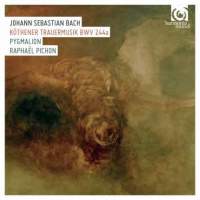Texte paru dans: / Appeared in: |
|
|
Outil de traduction (Très approximatif) |
|
|
|
|
|
Reviewer: George
Chien Say you are rummaging around a Middle-Eastern bazaar, and you come upon a dusty old lamp, and you wipe the surface to get a better look, and a genie appears! You waste your first wish asking for a million bucks and your second getting rid of all that unmanageable livestock. You are a music lover. Would you wish for (a) Sibelius’s Eighth Symphony; (b) the third and fourth movements of Schubert’s B-Minor Symphony; (c) Mozart’s completion of his Requiem; or (d) a lost major choral work by Bach? Of course, only (d) is known to have existed in tangible form, and, in fact, there would be many candidates to fulfill that wish. Well, now you can strike one from that list and perhaps (d) from your wish list. In 1728, upon the death of his beloved former employer, Prince Leopold of Anhalt-Cöthen, J. S. Bach was asked to provide music for a memorial service, which he did, borrowing from two Leipzig-era compositions, the St. Matthew Passion and the Trauer-Ode (Cantata 198). That was only fair, I suppose, since during his tenure at Leipzig Bach regularly adapted music he had composed at Cöthen. Lamentably, the music for this grand funeral cantata has disappeared. All that remains is the text, preserved in the program for the memorial service. Some attentive readers may recall that I once dismissed Candle in the Wind, Elton John’s tribute to the late Princess Diana, as “used” (i.e., previously owned) music, contrasting it with a theoretical funeral ode that Bach might have penned under comparable circumstances. I envisioned a “brand-new 30-minute work for four soloists, a chorus of from four to eight voices, and a full orchestra.” Well, here it is! Except that the Köthener Trauermusik runs 74 minutes and—whoops—it’s all “previously owned” music. On the other hand, I did claim that it “would have been a masterpiece, a work for the ages,” which aptly describes Köthener Trauermusik’s antecedents. As early as 1873 Wilhelm Rust discovered that the texts of 10 numbers of the lost funeral cantata fit the music of 10 numbers of the Passion. Perhaps significantly, both librettos were the work of Picander, one of Bach’s favorite librettists. As late as 1951 Friedrich Smend noticed similar correspondences between two choruses in the Köthener Trauermusik and Cantata 198, the Trauer-Ode. A musical source for the missing piece, the Dictum, was suggested by Klaus Häfner: the second Kyrie of the B-Minor Mass. All that remained was to find two suitable recitatives, which Rafael Pichon and Pygmalion did after experimenting with a number of possible alternatives. Armed with these insights, Morgan Jourdain, in collaboration with Pichon, fashioned the very credible reconstruction presented in the recording. Of course, even when Bach borrowed heavily from existing works he often included something new. We’ll never know, but it’s unlikely that this or any reconstruction will ever be an exact reproduction of the lost score. (Note: Andrew Parrott has recorded a slightly different reconstruction for Avie, which I’ve not heard, and upon which I’m not qualified to comment.) Current practice honors Carl Philippe Emmanuel’s observation that his father favored fast tempos. Pichon is guided by it, but there are instances when it seems inappropriate. The opening chorus (“Moan , children, moan to all the world….”) is positively bouncy, and a bass aria (“Rest in peace….”) is distinctly restless. These days we tend to favor “celebrations of life” over funerals. I’m not sure that was the case in Bach’s time. Shorn of their textual contexts, Pichon’s readings seem fine. Overall, Pichon’s interpretation satisfies. Pygmalion’s choir (26 voices, sometimes divided) is splendid throughout, as is its orchestral complement. The solo quartet, too, is outstanding. As for the music, you might think of it as a sort of St. Matthew Passion-lite. You can’t get better than that, unless you listen to the St. Mathew Passion whole. As for that genie, with this Köthener Trauermusik securely in hand, you might want to reconsider your third wish. How about: (e) the completed final fugue of The Art of Fugue? Meanwhile, enjoy this disc. | |
|
|
|
|
Cliquez l'un ou l'autre
bouton pour découvrir bien d'autres critiques de CD |
|




